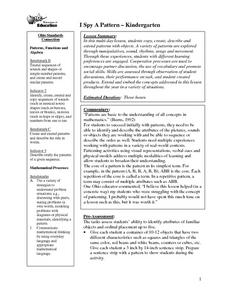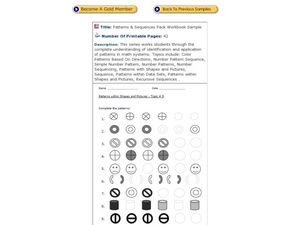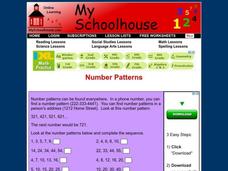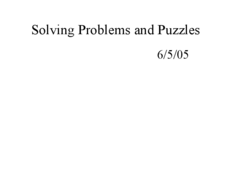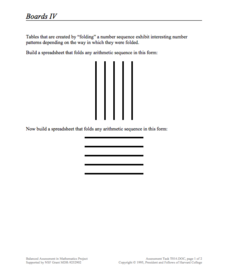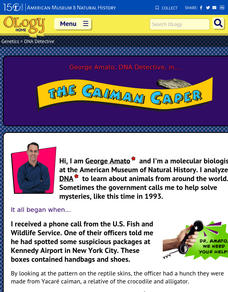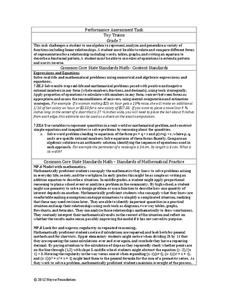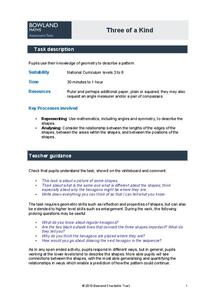Curated OER
Find a Pattern problem solving 6.6
In this finding a pattern using a table instructional activity, students write what they know and need to find out, make a table to show a pattern, and solve the pattern sequence. Students write nine answers.
Curated OER
Animal Diaries
Students read Diary of a Worm by Foreen Cronin. In this journal writing lesson plan, students research an animal and write a diary by their animal. Students apply the research they've completed in their writings. Students share their...
Curated OER
A Piece of Pi
In this piece of Pi worksheet, students examine pi. They count how many times a given digit appears in the list of digits. Students describe their observations and conclusions regarding pi. This one-page...
Curated OER
Sequences
In this sequences worksheet, 6th graders solve and complete 3 different types of problems. First, they complete the missing numbers and determine the term-to-term rule. Then, students find the nth term of each sequence and draw the next...
Curated OER
I Spy a Pattern-Kindergarten
Students copy, create, describe, and extend patterns with objects. They explore a variety of patterns through the use of manipulatives, sound, rhythms, songs and movement. Cooperative processes are used to encourage partner discussion.
Curated OER
Patterns Within Shapes and Pictures
In this patterns within shapes and pictures learning exercise, students look at the shapes and pictures, then color or draw to complete the pattern.
Curated OER
Practice With Patterns
In this pattern instructional activity, students explore sequence of numbers. They identify the next number in a sequence. This one-page instructional activity contains 30 problems. Students may check their answers online.
Curated OER
Number Patterns
In this online interactive number patterns worksheet, students read examples and use their problem solving skills in order to solve to 22 problems that require them to complete number sequences.
Curated OER
Guess That Sequence!
Pupils analyze number sense by participating in a pattern identification activity. In this number sequence lesson, students examine several groups of numbers and identify the sequence in the group before adding on to it. Pupils check...
Curated OER
Sequence Clue Words (Part 1)
Does your class know they can use sequence words such as, next, finally, after, and then to better understand the sequence of a story? First they discuss sequential order and sequence words, then they look for sequence words as they...
Curated OER
Sequence Clue Words (part 2)
If you've already discussed using sequence words to determine the sequence of events in a story, then a follow up lesson is definitely in order. They read the story, My Apron by Eric Carle and look at the sequence clue words such as...
Curated OER
Logical Sequence
Students examine logical and illogical sequences in writing. They identify illogical sequences of sentences in a letter. Students retell short stories using a logical sequence and students place sentences in logical order.
Curated OER
Learning about the World of Color, Object and Shape Patterns
First graders practice identifying and creating patterns by using unifix cubes. In this visual design lesson, 1st graders investigate reoccurring patterns using colors and shapes and extend what is being made with their unifix...
Curated OER
Converge or Diverge?
Learners prepare for the calculus concepts of limits by examining sequences that converge and diverge. By using an Excel program that generates sequences, students manipulate the starting number, multiplier and add-on values, and examine...
Curated OER
Solving Problems and Puzzles 1
Plug in this presentation for a quick start to your day. The class reviews the 6 times tables how they relate to division and then work through patterns to build logical reasoning and sequencing skills. A wonderful warm up or problem...
Curated OER
Learning about Fibonacci
In this learning about Fibonacci worksheet, students read about Leonardo Fibonacci and his contribution to mathematics, then study the pattern of Fibonacci numbers, in math and in nature.
Curated OER
Visuals Patterns in Pascal's Triangle
Students examine Pascal's Triangle and attempt construct it on their own. In this visual patterns instructional activity students explore patterns that exist in Pascal's triangle.
Concord Consortium
Boards IV
Build a connection between algebraic sequences and spreadsheets. Learners examine a specific folding pattern and convert the pattern into a spreadsheet. The goal of the spreadsheet is to produce a sequence of a specific pattern modeled...
Mathematics Vision Project
Module 4: Linear and Exponential Functions
Sequences and series are traditionally thought of as topics for the pre-calculus or calculus class, when learners are figuring out how to develop limits. But this unit uses patterns and slopes of linear functions in unique ways...
American Museum of Natural History
DNA Detective
Match up the DNA code. Pupils read the website from the American Museum of Natural History about how DNA can determine whether a skin is from a particular type of reptile. Using the same technique, learners match up products with the...
CK-12 Foundation
Recursive Formulas: Fibonacci Sequence
Explore the building blocks of the Fibonacci Sequence. Given the lengths of sides of squares, pupils deduce the pattern to determine the lengths of two more squares. Learners continue to work with recursive formulas to generate numerical...
Noyce Foundation
Toy Trains
Scholars identify and continue the numerical pattern for the number of wheels on a train. Using the established pattern and its inverse, they determine whether a number of wheels is possible. Pupils finish...
101 Questions
Toothpicks
Analyze patterns and build functions. Young scholars work on their modeling skills with an inquiry-based lesson. After watching a video presentation of the problem, they write functions and make predictions.
Bowland
Three of a Kind
One is chance, two is a coincidence, three's a pattern. Scholars must determine similarities and differences of a regular hexagon undergoing dilation. They look at lengths, angles, areas, and symmetry.




